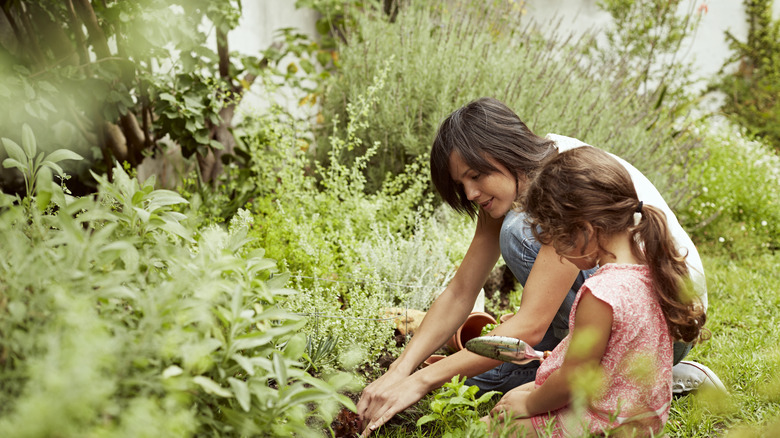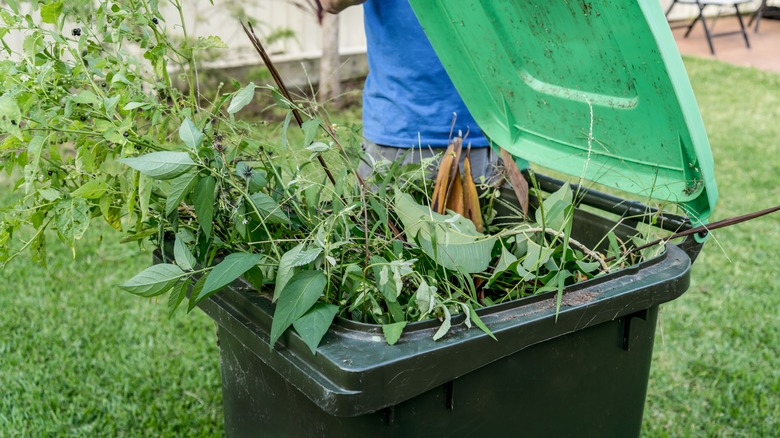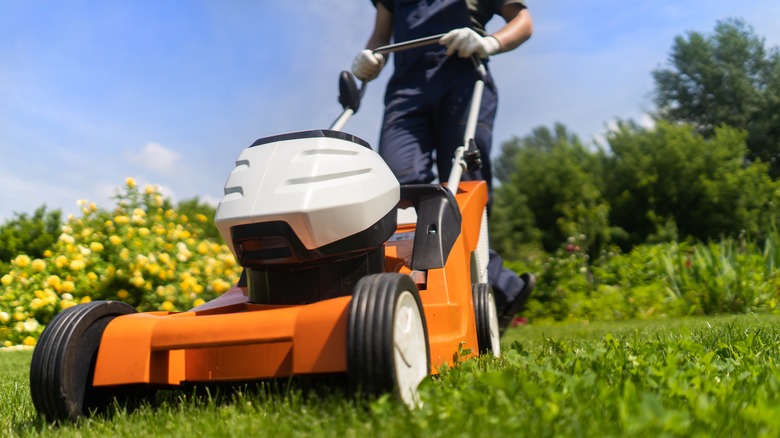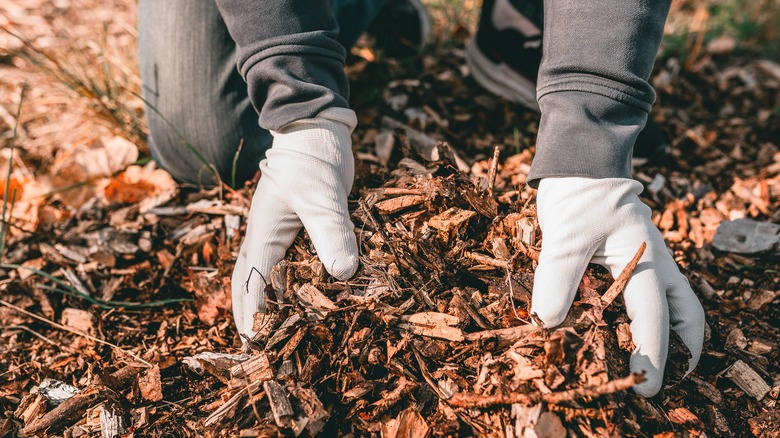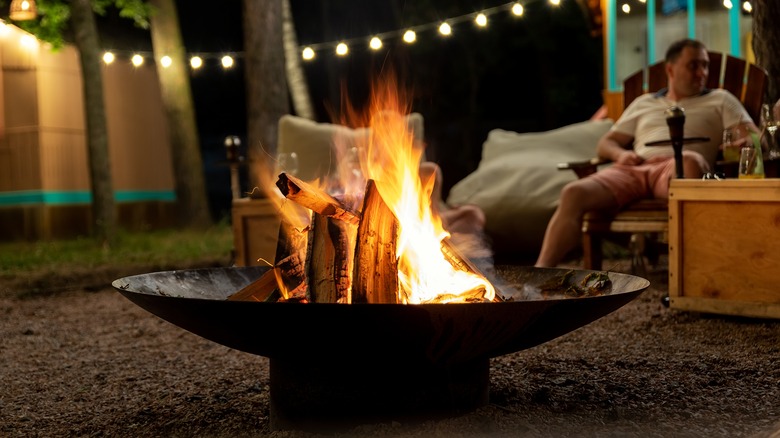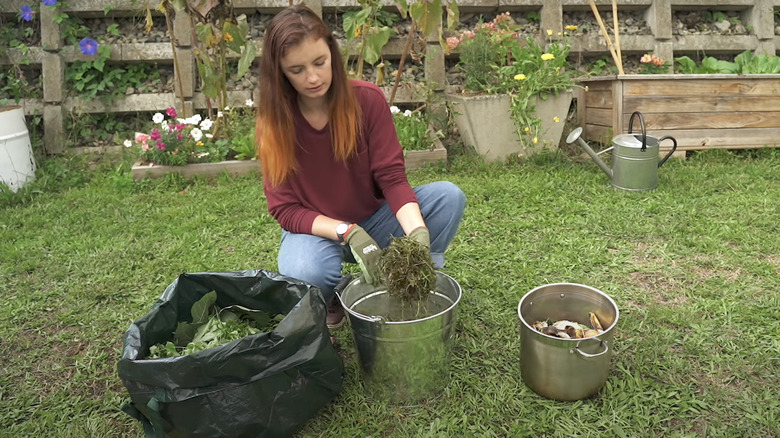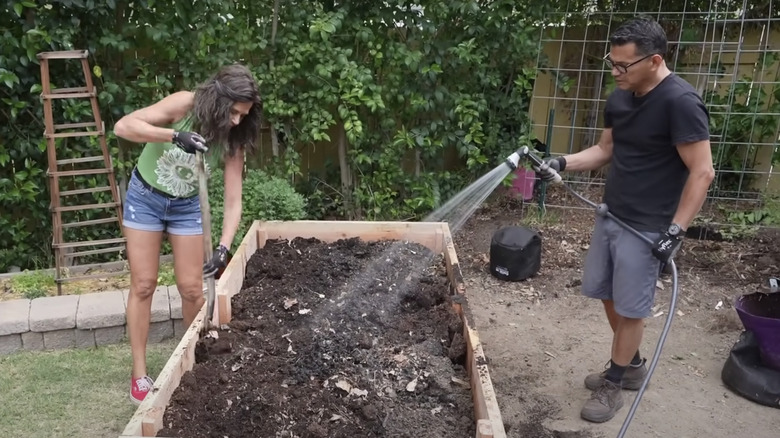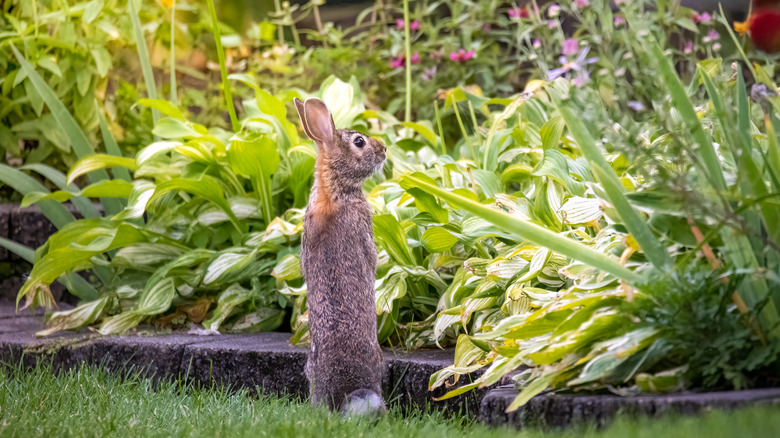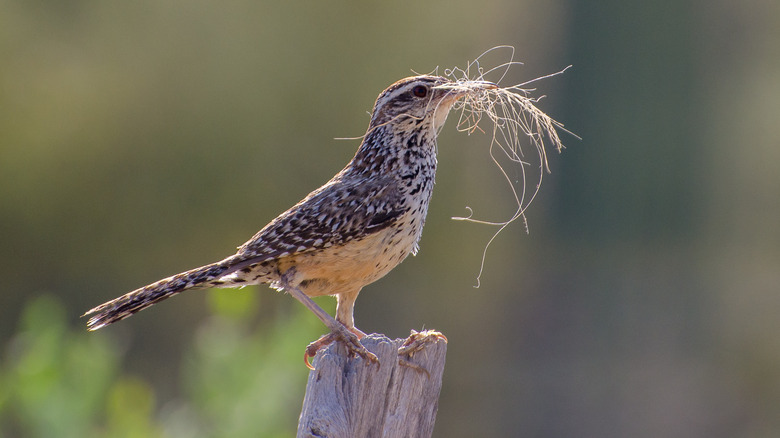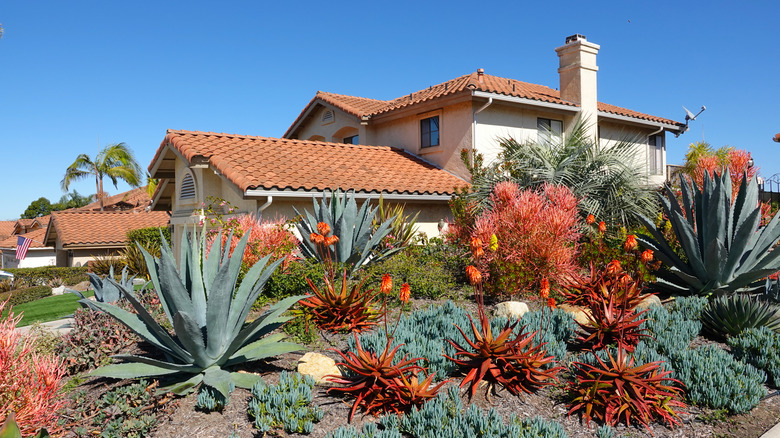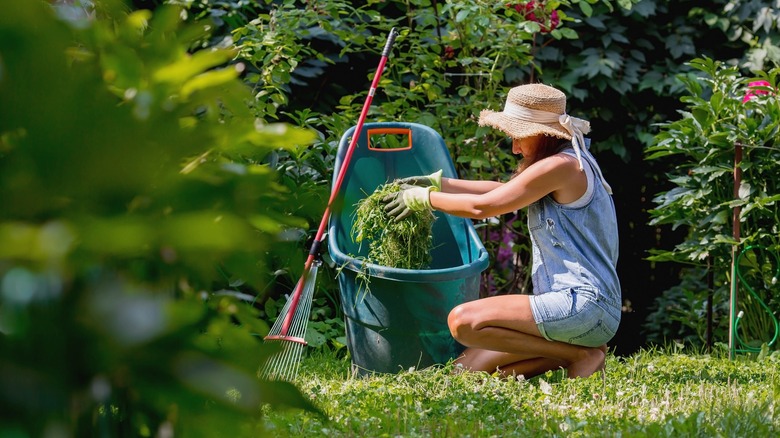10 Easy Green Methods To Get Rid Of Your Landscaping Waste
After spending hours in the sweltering sun doing yard work, most people drag their bag of leaves, twigs, and grass clippings to the curb and call it a day. What you may not realize is that this is just about the worst thing you can do with leftover yard debris. Sending off your collection of grass, flower, and tree litter with the rest of your household garbage just adds more refuse to local landfills. Landfills are filling to capacity at alarming rates, and we should be concerned. The rural midwest is estimated to have decades left before they run out of space, but more urban areas could be running out in the next five years (via Roadrunner).
Yard trimmings used to take up nearly 20 percent of landfills, according to a 1991 Environmental Protection Agency study, but that number reportedly dropped to 12.1 percent in 2018 (via EPA). The reason for this change was due to raised awareness of the importance of properly disposing of organic materials. There is no reason to send your yard waste to landfills and expedite a future crisis, not when you can take so many alternative actions. Embarking on a greener approach to disposing of plant scraps doesn't have to be tedious. You can have it picked up for you, re-use it for other household purposes, and sometimes even leave it where it lays. Below are ten eco-conscious methods for disposing of yard waste that will reduce your landfill contribution and benefit your local environment.
Join your municipality's pick-up or drop-off program
Contrary to common belief, eco-friendly living doesn't have to be complicated. Many municipalities make "going green" easier on local residents by offering a local pick-up or drop-off program for yard waste. Pick-up programs may run year-round or occur seasonally, allowing residents to set aside yard debris during popular times of the year, such as during the autumn leaf changes.
Finding instructions within your town isn't a hassle; call the city contact number for information or do a quick online search in your area about what they offer. Regarding pick-up, many cities prefer you leave your yard waste in compostable paper bags, or they permit plastic bins which they dump in the back of an industrial dumpster truck. If your city doesn't pick up, you may need to search for a collection site. Make sure you solely transport yard waste to the site and read up on any sorting instructions beforehand. Many yard waste sites do not accept food scraps and other garbage because this attracts unwanted rodents and causes a foul odor in their location, so your best bet is to leave these items behind.
Grasscycle after mowing
Grasscycling is exactly what it sounds like. It's an approach to mowing your lawn that re-uses the glass clippings, keeping them out of landfills and from polluting the environment. Instead of taking time to collect and dump grass clippings, property owners should leave this organic debris alone, as it provides a natural nitrogen boost for lawns and eliminates the need for chemical fertilizers. According to LebananonTurf, grasscycling provides up to five pounds of nitrogen per year, which meets the University of California Agriculture and Natural Resources' recommendation for nutrients. These clippings also reduce how much water your lawn needs and help to aerate the soil.
In order to partake in grasscycling, you will need to keep up with a frequent mowing schedule. Mow your lawn no more than 0.5 to 3 inches at a time, depending on the type. You can only let it grow up to a certain length, again depending on the grass species, which is usually around 0.5 to 4.5 inches tall. CalRecycle has a useful chart for calculating when you should mow your lawn. Fortunately, most mower models are up to this task, meaning you won't have to make any special investments to get started.
Create DIY mulch for your landscaping
Between mowing your lawn, trimming trees, and pruning gardens, it's common to end up with a pile of grass clippings, twigs, branches, and leaves. Instead of chucking all these organic materials into a bin and dragging it to the dump, consider using a wood chipper to create your own homemade mulch. This is a great way to reuse "waste" on your property while saving the environment and your money. Instead of going out and buying large plastic bags full of the same organic materials, you'll have homemade wood products to rely on.
One of the most common times to have excess yard waste is just before winter, as many homeowners trim and prep their plants for the extreme temperatures up ahead. If you live further north, falling autumn leaves also provide copious amounts of organic material. The timing is perfect since you'll need all the mulch you can get to provide shelter and heat retention for your garden plants throughout the winter.
All you need to do is collect the materials and place them in the chipper, running them through until you have piles of mulch to use at your behest. If you don't have a chipper, you can easily find one at a local home improvement store, where smaller ones cost between $100 to several hundred dollars on average. If this price is a bit out of range, and you won't be using one more than once or twice a year, you can also look for rentals in your area.
Burn excess twigs and branches, if permitted by your city
If you have any classic wood-burning appliances around your home, such as a stove, fireplace, or fire pit, you may be able to utilize your yard waste to fuel your interests. Consider collecting dried twigs and logs from your property with the intent of using them later. Store them outdoors or in a garage, uncovered and above ground, so they have proper ventilation until you need to power up your home appliance or light up your fire pit. Most people keep their wooden fuel on slatted pallets, which can be moved indoors during the winter or periods of heavy rain.
When it comes time to use the leftover wood, you need to take proper precautions. Before lighting up your stove or fireplace indoors, you must be well-versed in the process, such as keeping the logs spaced and arranged in proper rows. The appliances you're lighting up should provide air circulation and ventilation in their design, making it safe to burn yard waste without concern.
However, if you're going to be burning your wood outside bonfire-style, you may need to take additional precautions. Depending on your state, you'll need to follow specific burning laws, especially if you're in a location susceptible to wildfires. Make sure you're burning a pile small enough that it doesn't need authorization, that only contains yard waste, and that you're a safe distance from any houses, trees, or other flammable materials. Don't mix in any household garbage that isn't organic matter from your yard– these materials are usually illegal to burn.
Create your own compost for fertilizer
If you want to play a more direct role in reducing yard waste and ensure it's breaking down properly, modern technology provides ways for households to partake in the process. You can always try your hand at composting, a trend that's taken off ever since high-tech household composters began flooding the market. According to Businesswire, 61 percent of US consumers are concerned about sustainability when making home purchases, making it unsurprising that many major retailers sell electric composters.
If you're unfamiliar with the practice, you should know that composting is the process of storing organic products together to make them break down faster. Fruit and vegetable scraps, grass and plant clippings, and other biodegradable products are high in nitrogen content, causing them to break down faster than if they were mixed in standard dumps and landfills. Depending on how much you plan to compost, you can purchase a tabletop kitchen bin or use an outdoor can. Compost should be "turned" to mix it regularly, especially when adding items to it, and several composting bin models are fashioned as tumblers to make this process easier.
Once the compost finishes decomposing and assuming you have no need for it for yourself, you can donate it to local schools, community gardens, farms, and even to gardeners and landscapers through Craigslist. On the other hand, you may intend to use the compost yourself, as most people do. If you have houseplants or an outdoor garden, the homemade concoction will serve you well as an all-natural fertilizer for your plants.
Use the compost to build raised garden beds and planting mounds
In addition to fertilizing pre-existing plants, you can also use compost to create all-natural spaces to raise new ones. There are many benefits to cultivating plants in homemade raised garden beds. These cozy garden nooks have excellent drainage, retain temperatures, and separate your plants from non-domesticated weeds and plants in the area. They also make caring for your garden easier when elevated high enough since you won't have to lean over or bend down as much while watering, fertilizing, pruning, and harvesting plants.
Building these beds is fairly easy, depending on how much work you want to put into it. Some people choose to pile soil and compost without any boundaries, while others build walls and platforms out of stones, masonry, and wood materials. Almanac says the bed length doesn't matter but recommends keeping the width under 4 feet to ensure you can reach the centermost plants without stepping onto the platform. However, if the bed is built against a wall, you don't want it more than 2 to 3 feet wide since it won't be accessible from the other side. If you're planting deep-rooted crops, you'll need a lot more soil and compost– at least enough to be 12 inches deep. In contrast, shallow-rooted crops only need about 6 inches. Almanac also advises that compost should make up about 40 percent of the garden bed, while soil makes up the rest. Based on this advice, you should calculate how large of a bed you can create based on how much compost you have (or plan to have) before beginning construction.
Feed the local wildlife
Outdoorsy people tend to appreciate nature's many forms, including the land and the animals that dwell upon it. What better way to re-purpose your yard waste than to use it to benefit the local wildlife? The next time fresh leaves fall from your trees, bushes, and flowers, let them sit or rake them to an area that won't affect your landscape aesthetic. According to World Centric's zero waste manager Lauren Olson, various animal species can use these leaves to thrive in their natural habitats (via Martha Stewart).
Amphibians, mammals, and reptiles eat leaves and use them for shelter. Instead of wasting time collecting them into trash bags that end up in landfills, encourage a healthy ecosystem on your property. It's true that landfills do have their own ecosystems and are often populated with rodents. However, given the array of foods and materials in dumps, it's unlikely that animals will seek out bagged leaves over other resources, therefore reducing the yard waste's usefulness and potential. Fallen leaves serve a much more practical and wholesome purpose when left where nature intended them; within reach of the animals who also call your neighborhood home.
Give twigs and leaves to migrating birds to nest with
There are hundreds of tricks on the internet for attracting birds of all kinds to your property using birdseed, feeders, nesting boxes, and other purchased items. However, one of the easiest ways to attract birds to your property also conveniently clears up some of your yard waste. Twigs, leaves, pine needles, and other dried-out plant matter are common materials found in birds' nests. Many bird species also use catkins, which are soft tree flowers, for their elevated roosts. If you have any catkin-bearing trees, including the birch, oak, walnut, wax-myrtle, and willow families, you may have already noticed the birds taking care of fallen flowers for you.
During periods of mass bird migration, you can take advantage of the birds passing overhead by putting out your yard debris for them to take. Depending on where you live in the United States, birds fly either north or south during spring and fall. The specific months vary since birds don't follow a calendar; they begin their travels in response to seasonal changes. Keep in mind that most bird species don't nest year-round. They build nests solely for raising their young, meaning they won't be looking for nesting materials during the winter. Conveniently, this is also a time when most plants and grass are dormant or buried beneath a pile of snow, meaning you shouldn't have as much yard debris to clean out anyway. Overall, this tip is better served for the warmer months when plants flourish and birds migrate back to their summer homes.
Transform your yard into a xeriscape
While there are many ecological approaches to taking care of yard waste, there is arguably no better way to keep these materials out of landfills than not to have them in the first place. Xeriscapes are a type of landscape that requires little water, upkeep, and caretaking throughout the year. If you've visited or live in the southwestern United States, you've likely already caught notice of this trend in local neighborhoods and outside storefronts. Xeriscaping is an alternative approach to landscaping where grass lawns are replaced with sand and rock, and succulent plants take the place of traditional trees and flowers.
In writing, these landscapes sound rocky and desert-like, but in reality, they can appear as lush gardens filled with diverse plant life. These types of yards are very different than traditional styles, as there is no fast-growing grass to trim. Plants need minimal pruning and weeding, meaning there's almost no yard waste to clean up after. Building a xeriscape has other eco-friendly benefits; homeowners can reduce their water usage by over 50 percent and use less chemical fertilizers throughout the year (via Frontsteps). Using less water means less is being taken from freshwater sources, keeping the natural ecosystem well-saturated, debris-free, and healthy.
Share with your neighbors (as long as you have consent)
Even if none of these methods are to your liking, remember that one person's trash is another person's treasure. Whether it's a friend, neighbor, or acquaintance, you might know someone who can put your yard waste to good use. As explained above, people may want your old branches for firewood or twigs and leaves for composting. The arrangement is yours to make, and you may find an easy way to get spare yard waste off your hands while providing a service to someone else.
The customary approach to finding a "buyer" for your yard waste is simply asking around. If you know anyone with a farm, garden, or firepit in their backyard, they're a good place to start. Another option is to post in online groups, such as Facebook Marketplace or Craigslist, where locals in your area can see and share your offer. When a large tree is cut down, you can even leave the logs in your front yard with a sign offering, "Free Firewood," as long as your neighborhood homeowner's association permits this display.
